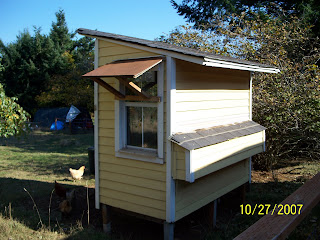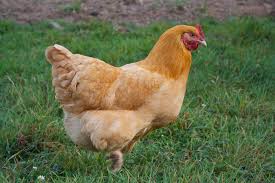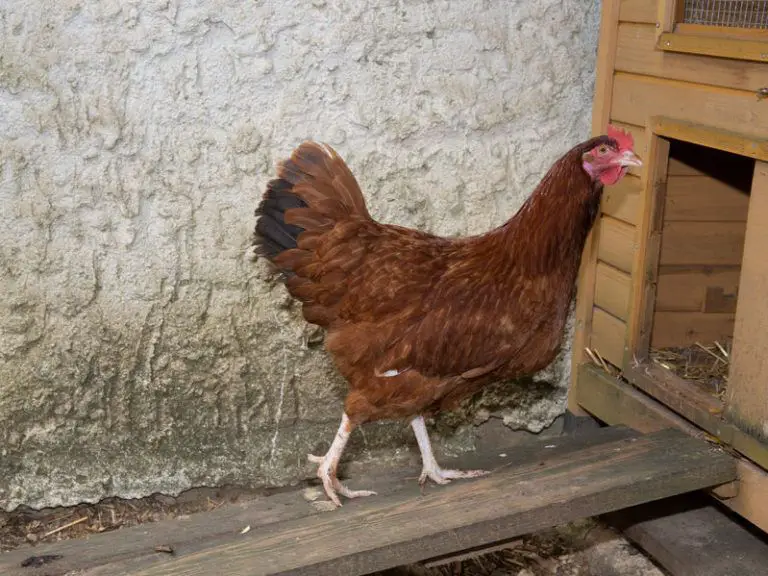Chicken Coop Guide – Read This Before Building Or Buying Your Coop!
So you’ve decided it’s time for a new coop…maybe you’re brand new to raising chickens and are excited about finding a new home for your feathered friends. Or maybe you’ve been raising chickens for awhile and you simply need a larger coop.
Whatever your situation, I hope to provide you with the needed information on what to look for in a coop that will adequately suit your needs!
If you’re thinking of building a coop, check out the links to FREE chicken coop plans on the side of this page.
What To Consider When Building Or Buying Your Coop
What Design to Use?
There are hundreds of chicken coop designs to choose from…which one you pick will depend on your situation. If you’re only planning to get a few chickens for eggs and you live in town, you may be able to buy or build a small mobile coop, also called a chicken tractor. Great for 2 – 6 chickens, depending on the size of the mobile coop.

If you want to raise between 6 – 12 chickens, you’ll want a larger coop. When buying or building a larger coop, it’s much harder to make it mobile because it’s so much heavier. I have seen larger mobile coops in the country when they have a tractor to move it around the farm. But for a lot of us, we will just build a medium sized coop that is stationary. A run can be added, or not, depending on your preference.

If you are really wanting to go all out with chickens, you will be buying or building a coop to hold 12 or more chickens. In this case, you’ll want to consider putting together a Large Coop! There are many designs available – it really depends on what you are looking for. Here again, you’ll have to decide if you want to add a run to the coop, or just let them free range on your property.

How Many Chickens?
This may not seem difficult to figure out at first. It wasn’t for me either…I thought 8 chickens was perfect so I looked up how big of a coop to make for 8 chickens and made it! Simple enough, right? But then we discovered raising chickens was fun and decided to get a few more…and, you guessed it – suddenly my coop was too small.

We made it work by doing a weird add-on to one of our other sheds, but it would have been easier to simply make a coop big enough to handle a few more birds than we thought we would need! I’d recommend you think of doing the same…just in case!
How Big Should Your Coop Be?
The suggested space needed per chicken is dependent on size of chickens:
Small chickens (like bantams, silkies) need 2 square feet (sf) per bird.

Medium Chickens (like Leghorns, Delawares) need 3 sf per bird

Large Chickens (Buff Orpingtons, Barred Rock etc.) need around 4 sf per bird.

So, for example, if you were planning on getting 10 medium sized chickens, you would multiply 10 chickens X 3 sf = 30 sf.
For perspective, a sheet of plywood you buy from a box store like Home Depot or Lowes is 4 ft by 8 ft, which equals 32 sf or (4X8 = 32). If you used a sheet like this for the floor of your coop, it should hold between 8 to 16 chickens…(32 sf / 2 sf per chicken = 16 chickens; 32 sf / 3 sf = 10 chickens ; 32 sf / 4 chickens = 8 chickens).
My yellow chicken coop (pictured below) had a 4 ft x 8 ft floor in it…we bought a mix of 8 medium and large sized chickens and it worked swell! (until we decided to get more of course:)

I hope this helps provide some ideas for your coop size. Just remember, you never know just how many chickens you’ll end up with!
Will You Need A Chicken Run?
Chickens are much healthier (and likely happier) if they have an area to run around in, scratching the ground looking for bugs, seeds etc. This can involve just letting them free range outside the coop or, if you like to have them more contained for safety reasons (or simply to keep the poop off your lawn), a contained outdoor space is helpful.
If you live on acreage, you may or may not need a chicken run to accomplish this. I am fortunate to have a pasture area where they tear around all day. They’re fenced in with woven wire and hang out with my cows and have a grand ole time!

However, I still have a small run below the coop as an area for them to escape from aerial predators which, in my locale, are hawks and owls.
The girls are often found bunched together there at times, appreciating an escape from the “would be” predators. Not only that, it’s and area with thick bedding and they use it to take a “dust bath” to smother any lice, parasites, or mites.
If you don’t want chickens running around your lawn…or porch, deck, sidewalk etc., a run can help keep them contained yet allow them to get a chance to be outdoors doing what chickens do – hunt for bugs, scratch at the ground, and be a great source of entertainment for you! And it allows them safety from predators – a key reason for considering a chicken run.
Determining Size of the Run – The math for estimating a Chicken Run is different than determining the square footage of your coop. For a run, figure about 8-10 sf per chicken, which is a bit more space than what’s needed for your coop space.
Ok – so on to a bit more math now to figure this out (this is the last of the math, I promise:)…as an example, if you have 8 chickens at 10 square feet per bird, you will need 80 sf of space in your chicken run (8 x 10 = 80). Pretty simple really. It doesn’t matter if you do an 8 ft x 10 ft run or 5 ft by 16 ft run or whatever dimensions you choose – as long as it provides adequate space for your chickens!

If you live in an area with a lot of predators, you may want to consider burying the wall of the run around 8 – 12 inches below the ground to prevent coyotes, fox, and the like from digging under your run to get inside and nab your flock.
For most situations, this is unnecessary. But if you live in the country where there are more chicken eaters, it may be something to consider.
Is The Coop Easy To Assemble? Check Customer Reviews To Find Out
If you’re buying a chicken coop, it can be helpful to read reviews of the coop you’re considering buying to see if people had difficulties assembling it up or not. If it was difficult, people WILL add that in their reviews.
The opposite is also true – if putting together their coop was a painless experience, reviewers will note that as well. Reviews are super helpful! And most websites that sell coops will have an ample number of reviews (both positive and negative) so help you make your choice. A few good websites that sell coops online are Amazon, Wayfair, and Pinecraft. Many include free shipping.

If you’re a handy person, buying and assembling a chicken coop may not seem like a big deal to you, but if you’ve never assembled something this big (which was me when I built mine), it’s something to keep in mind. I think building your own coop or assembling a coop you buy is something anyone can do!
If you’re not a carpenter, no biggie. Just take some time to watch a few Youtube videos (there are hundreds), read a few articles on it, talk to others who’ve already made a coop etc. It really can be fun.
But there are a lot of pre-assembled chicken coops you can buy online or at your local farm stores that will work nicely if you like the simplicity of having it all done for you! At many farm stores where they sell coops, they will often help you assemble the coop at your home.
Other Ideas…
Another option is you can find a handyman you know of, or check in the “Services” section on Craigslist to find someone who can assemble it for you. In fact, Craigslist is another place to buy a reasonably priced USED coop (and occasionally a FREE one, but this is rare)
It’s how I found my most recent chicken coop! It may not be pretty, but it works great and I’m pretty sure the chickens like it just fine:) I’ll keep tweaking it over the years to get it the way that’s most functional for my flock.
Below is my little red coop…smaller than the coop I built a few years ago, but plenty sturdy and will hold up to 10 chickens…we have 8 chickens in it now, but I’m guessing we’ll have it filled by next year.

I’ve also found a few NEW coops listed in Craigslist which are made by DIYers in the local area, and they offer to deliver it to your house and set it up.
This may cost a bit more, but sometimes it’s worth it to know who you’re buying your coop from and that you’re getting a quality product.
Ease Of Cleaning
This is something to consider as well. Some chicken coop designs are not set up in a way that make them easy to clean out. Chickens are messy and poop a lot! When I built my first coop, I did not design it well in that regard…I did not think out the positioning of my roosts, feeders, or watering system. Pictured below is what happened…

I had positioned my roosts in a place that seemed logical when I built it, but left little room for my feeders and watering systems. I finally placed my Chicken Watering system outside, and moved the feeder to an area away from the roosts and problem solved…just one of the many things to learn when raising chickens.
——————————————————————————————————————————
Like This Article? Pin It
——————————————————————————————————————————
Other things to consider…
When designing your own coop, or shopping for a new one, make sure the design makes it easy to clean out, especially if you plan to clean it every week. If you can’t get at the floor space easily to clean it, you may want to look at a different coop design that allows for a better experience.
You’ll be hating your coop if it’s a major pain to clean! Open floor space without a lot of nooks and crannies, corner etc., will help. Also, if you can place roosts closer to the wall area vs. the middle of the coop will also make it faster and easier to clean.

Many professional coop builders have most likely eliminated these design flaws, but it helps to really examine the design of the coop you’re getting so you won’t have to make revisions to it later.
Is The Coop Predator Proof?
Elevating the coop off the ground about three feet can help to keep predators out. Coyotes, fox, raccoons, skunks, possums, cougars, hawks, owls etc. are all potential critters looking for an easy meal. Elevating the coop can deter them from entering! If you live in an urban setting, this may not be as much of an issue but there are plenty of raccoons in urban areas.

If you don’t like the look of an elevated coop, just make sure it’s sturdy enough to withstand a would-be chicken eater pawing to get at your birds inside. Once they realize they can’t get in, they won’t likely return.
What Chicken Coop Accessories Will You Need?
In addition to your coop, what else will you need?? Some coops will come with the following items, but many will not.
ROOST(S) – This is one of the easier coop accessories to make. Read More Here.
FEEDER(S)– These can be bought from your local farm store, online, or I show you a way to make a fun and FREE (or very cheaply anyway) feeder – See how it’s done here.
BEDDING – I recommend wood pellets for bedding, but straw or pine shavings can also be used. I buy 40 lb bags of wood pellets from the farm store or online . I cover the coop floor with several inches (around 3 – 6 inches deep) of the pellets. Then a couple times a week, just grab a rake or shovel and stir the poop into the bedding.

It really helps to reduce odors big time. If you think the odor seems to be getting stronger at any point during the year, you can add another 40lb bag of wood pellets on the top and continue just stirring the bedding a couple times/week. I usually clean my coop about once every year and that’s it! And the odor is always minimal. This is called the “deep litter” method which saves you time, money, and effort (and odor)!
WATERING SYSTEM – This is also fun to make! I show you how here, or you can also purchase a great selection of chicken waterers online. For more information on chicken watering systems, see this article.
——————————————————————————————————————————
Our Video Guide…
——————————————————————————————————————————
Closing Thoughts
There is a lot to learn about building or buying a chicken coop. I hope this information helps you in your chicken raising adventures. Good luck with your chicken coop experience.
Whether you choose to buy or build a coop, please leave a comment below about tips that may or may not have worked for you. We can learn a lot from one another – Thanks for stopping by!









My daughter has about 35 laying hens. She built a kind of cage in her barn so the chickens are more free-range and can go in and out of the barn at will except at night when she puts them in. The chickens lay their eggs wherever! I think it is a bit chaotic, but she seems to make it work. I would like her to build a coop, though. That could be built inside the barn, couldn’t it? Something with nests would work best, I assume. Or what do you think? I am just trying to help my daughter out. She is new to farming. When I grew up we had butcher chickens and had a building dedicated to them, but I want her to be able to have a productive flock.
Thanks for your comment Karin. It sounds like she has an ideal set up! She can easily use her barn and partition an area for her chickens. Or your right, she could also build a coop inside the barn, which is what others have done as well.
A few years ago we increased our flock size to nearly 60 and were selling eggs. We had a coop that housed about 20, and used a larger outbuilding for the rest. We dedicated that shed to chickens and removed everything else that was in it, created some roosts, nest boxes, feeders, watering system, and it worked great. We had contemplated building a coop inside of this shed so we could separate the flock and still have the rest of the building for storage but it was so much easier just letting the chickens have it:) Take care.
Yes I believed that the amount of chicken to be reared would really determine the kind of coop to be considered. Honestly, all you shared here is really great and honestly, I value all of these here. Thumbs up to you for sharing and to make things very simpler and easy to break down, thank you for sharing your post here with us all. Thanks so much
Thanks for your comment Kimberly – we hope the guide has given you some direction on how to get started raising chickens successfully. All the best to you.
Do you have a materials list for the 8×10 coop?
Hello, and thanks for asking. Unfortunately that plan doesn’t come with the materials list. There are a few plans that include it, but not of that size. This plan does: https://freechickencoopplans.com/free-chicken-tractor-plan-for-4-chickens/ but it’s obviously smaller. Or https://freechickencoopplans.com/free-4×8-chicken-coop-plan/ , also smaller than the 8×10 coop but has a list. Thanks again!